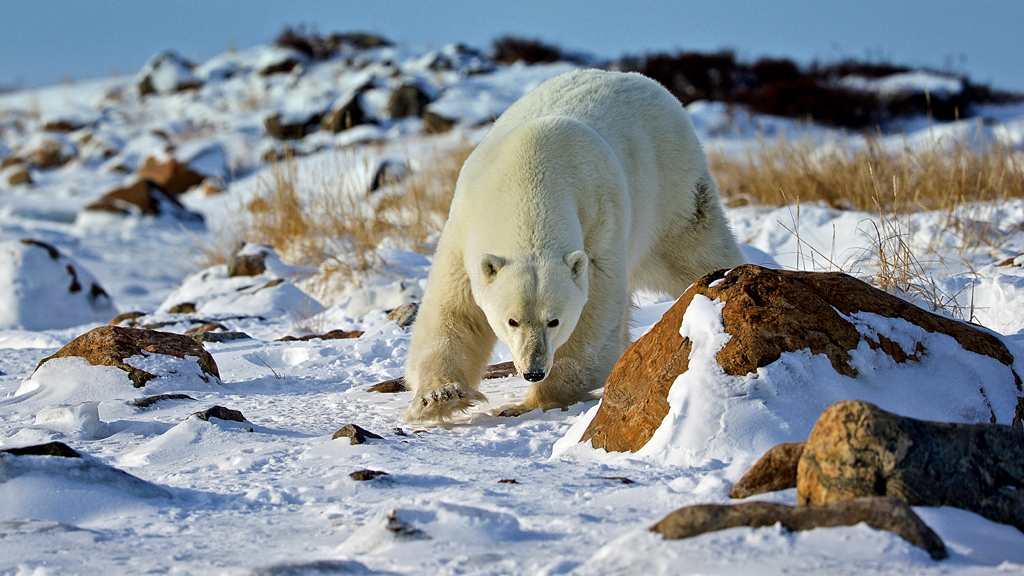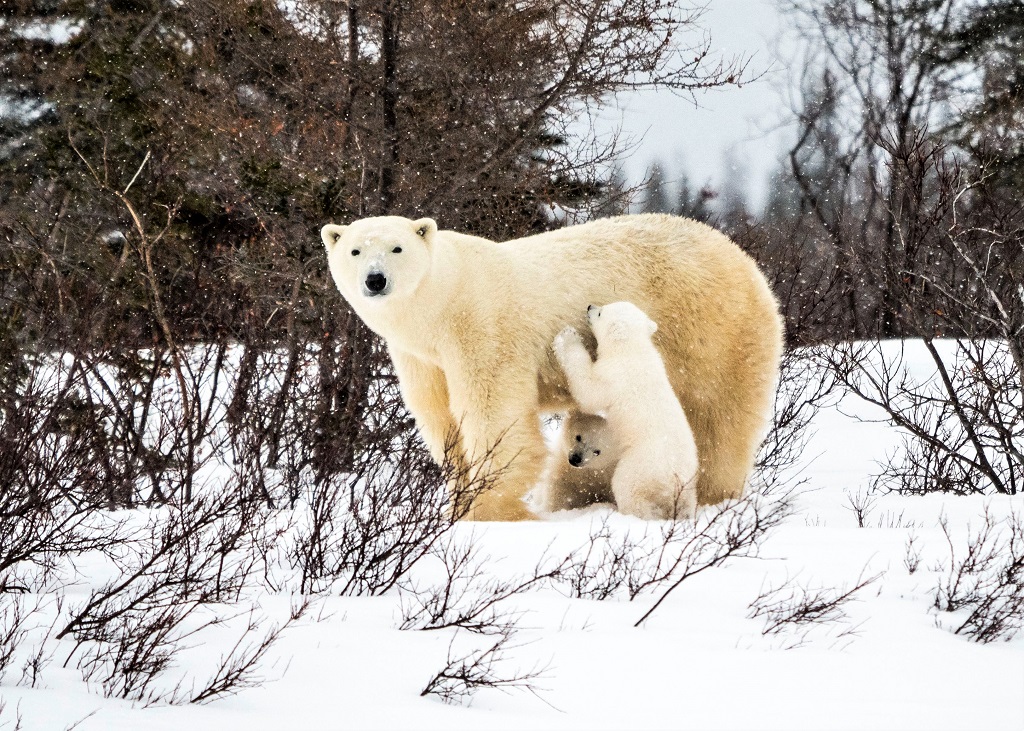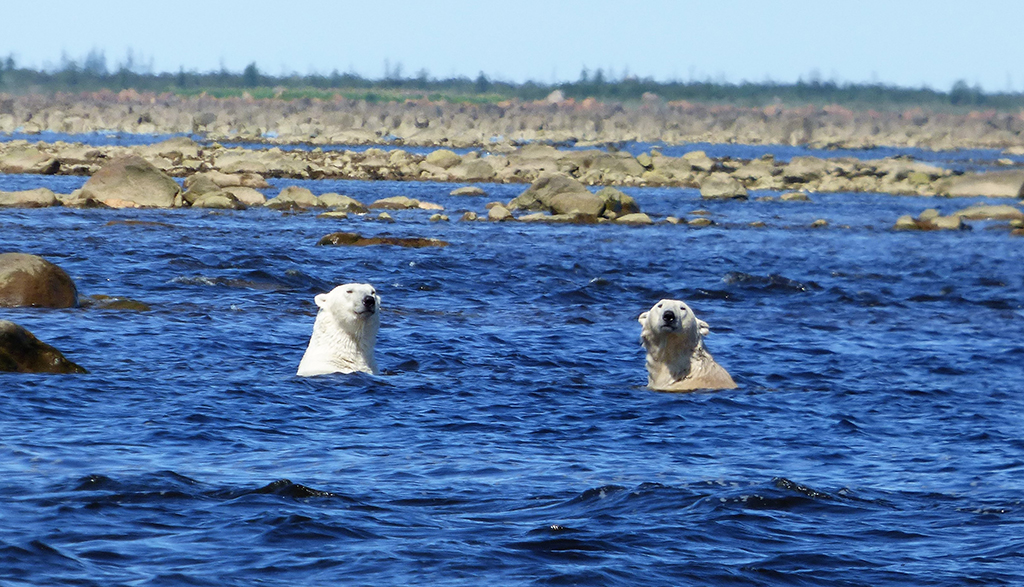More than two-thirds of the world’s polar bears are in Canada. Churchill Wild is home to the world’s first and only Polar Bear Walking Safaris based out of our fly-in-only remote Arctic lodges. Here at our eco-lodges, you will learn more about these fascinating animals and their home environment.
We’ve seen many bears over the years and learned a lot from observing and living among them. Each encounter is slightly different and unique from the ones before it. Polar bears are fascinating; seeing them in the wild will never get old.
Here are ten fun facts about the incredible marine mammals!
1. Don’t expect to hear them before you see them
Polar bears are not very vocal mammals. They tend to transmit their intentions through body language or posturing. For example, polar bears will wag their heads from side to side when they want to play. Hissing, snorting or a lowered head indicate aggression, while a nose-to-nose greeting indicates a request for something from another bear. When they’re angry, they will roar or growl. Thankfully, our expert guides know how to interpret their signals and keep all our guests safe while we’re out walking with these fantastic creatures.
2. They’ve got personality!
Polar bears’ personalities will vary due to life experiences, but all bears have the same fundamental nature at their core. They’re very intelligent, playful, and curious. We’ve never given them a reason to be fearful of us, so our mutual curiosity and respect translate into unique, on-foot encounters.
3. They’re ancient ancestors of the brown bear
Recent findings suggest that polar bears evolved between 350,000 and 6 million years ago from a common ancestor of the brown bear into the polar bears we know today. This evolution has made them ideally suited to survive the harsh environment they call home.
The body of a polar bear is ideally suited to the seasonal shifts in the Arctic. Their fur covers a thick layer of fat (up to 11.4 cm!), their ears and tails are small to limit heat loss, and their paws allow them to tread on thin ice.
4. Not all who wander are lost
Polar bears don’t have distinct territories, partly because their sea ice habitat constantly changes. When a young polar bear grows up, it may travel more than 1,000 kilometres (621 miles) to set up a home range apart from its mother’s, although sub-adult dispersal remains a scarcely studied topic because tagging and tracking a quickly maturing animal is tricky.
Scientists believe most polar bears limit travel to home ranges of a few hundred miles. However, they know of one satellite-tracked female that trekked 4,796 kilometres (2,980 miles) from Alaska’s Prudhoe Bay to Greenland to Canada’s Ellesmere Island and back to Greenland.
5. They’ve mastered sleep quality (and quantity)
Humans could learn a thing or two from polar bears about getting enough rest. They get seven to eight hours at night plus naps during the day. We often see evidence of this in the form of day beds created in snowbanks or tall grass around our ecolodges. Polar bears will usually nap after a meal or a swim, or if it’s too hot or blustery, they nap a lot. They can sleep right through a blizzard if they position themselves with their backs to the wind, nestled into a snowy ridge.
6. Females can delay pregnancy
One of the most incredible things about polar bears is their ability to delay the implantation of a fertilized egg. Mating takes place on the ice during the spring, between April and June, but the embryo will only implant in the fall and only if the mother has stored up enough fat to sustain her and her cub(s) during the denning season. If the implantation is successful, she will build a maternity den and remain there until March or early April, when the proud new momma emerges with her cub(s).
7. They know all about stealth mode
In the fall, seals cut 10 to 15 breathing holes in the ice, using the sharp claws on their fore flippers. Seals keep their breathing holes open all winter long and surface about every five to fifteen minutes at one of the holes or use air pockets trapped under the ice when available.
Polar bears locate these openings with their powerful smell and wait for the seals to emerge. They have to be intelligent and patient because the wait can be long — sometimes hours or even days.
Polar bears also stalk ringed seals basking on ice by taking advantage of their sleep-wake rhythms. The bear crawls slowly forward and freezes in place when the animal raises its head. At about six meters (20 feet) from the seal, the bear uses its explosive speed to pounce, killing the seal before escaping back into the sea.
8. They’re all about that keto diet
Polar bears got the jump on the keto diet!
A polar bear can eat 100 pounds of blubber in a single sitting, and when the hunting is good, they will eat only the fat and leave the carcass for scavengers. Unfortunately for seals, some of the best hunting is done in early summer as the ice breaks up and young seal pups are just learning to swim, making them easy prey.
9. Their fur isn’t white (fur real!)
Polar bear fur is made up of a dense, insulating layer and longer “guard” hairs on top. This dual-layer system prevents almost all heat loss, so much so that adult males can quickly become overheated when they run. And, surprise! Their fur isn’t white, it just looks that way. Each hair shaft is pigment-free, transparent, and has a hollow core that scatters and reflects light, making it appear white.
10. Their feet are paws-itively all-purpose
The polar bears’ paws are very wide, up to 30 cm across, which helps them disperse their weight and travel safely across thin ice. Black footpads on the bottom of each paw are covered by small, soft bumps known as papillae. Papillae grip the ice and keep the bear from slipping. Tufts of fur between its toes and footpads can also help with security.
Their paws aren’t just suitable for icy conditions but are also uniquely designed for the water. When swimming, the bear’s front paws act like large paddles, and its hind paws serve as rudders.











